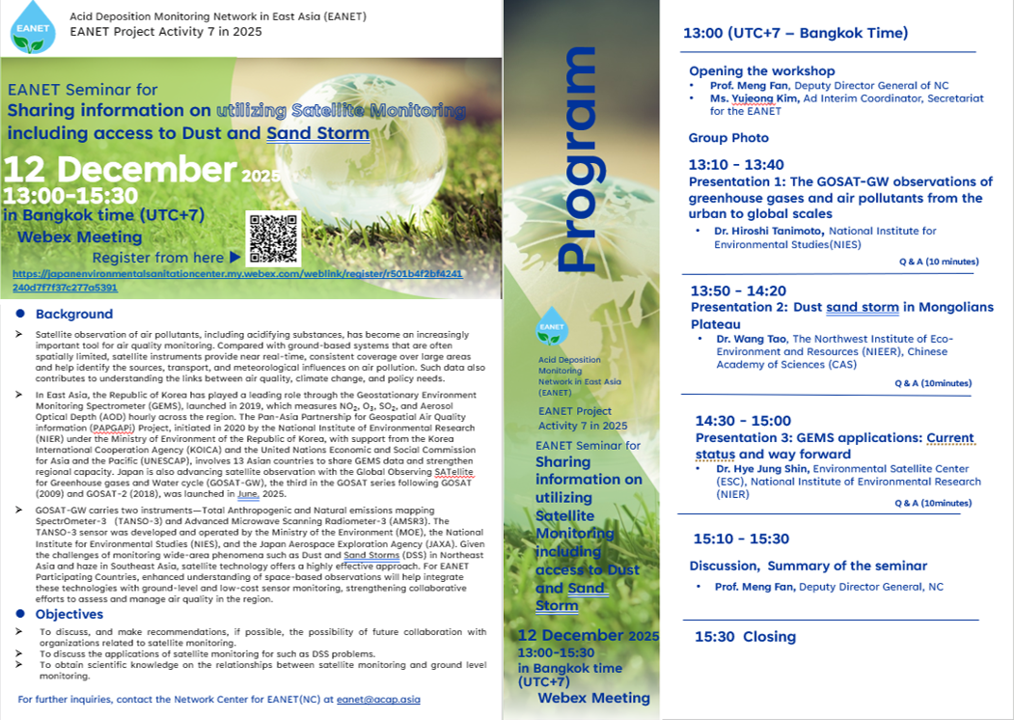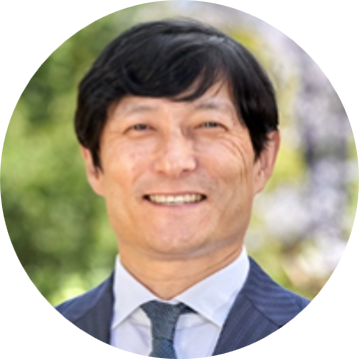
REGISTER LINK :
- Background
- Satellite observation of air pollutants, including acidifying substances, has become an increasingly important tool for air quality monitoring. Compared with ground-based systems that are often spatially limited, satellite instruments provide near real-time, consistent coverage over large areas and help identify the sources, transport, and meteorological influences on air pollution. Such data also contributes to understanding the links between air quality, climate change, and policy needs.
- In East Asia, the Republic of Korea has played a leading role through the Geostationary Environment Monitoring Spectrometer (GEMS), launched in 2019, which measures NO₂, O₃, SO₂, and Aerosol Optical Depth (AOD) hourly across the region. The Pan-Asia Partnership for Geospatial Air Quality information (PAPGAPi) Project, initiated in 2020 by the National Institute of Environmental Research (NIER) under the Ministry of Environment of the Republic of Korea, with support from the Korea International Cooperation Agency (KOICA) and the United Nations Economic and Social Commission for Asia and the Pacific (UNESCAP), involves 13 Asian countries to share GEMS data and strengthen regional capacity. Japan is also advancing satellite observation with the Global Observing SATellite for Greenhouse gases and Water cycle (GOSAT-GW), the third in the GOSAT series following GOSAT (2009) and GOSAT-2 (2018), was launched in June, 2025.
- GOSAT-GW carries two instruments—Total Anthropogenic and Natural emissions mapping SpectrOmeter-3 (TANSO-3) and Advanced Microwave Scanning Radiometer-3 (AMSR3). The TANSO-3 sensor was developed and operated by the Ministry of the Environment (MOE), the National Institute for Environmental Studies (NIES), and the Japan Aerospace Exploration Agency (JAXA). Given the challenges of monitoring wide-area phenomena such as Dust and Sand Storms (DSS) in Northeast Asia and haze in Southeast Asia, satellite technology offers a highly effective approach. For EANET Participating Countries, enhanced understanding of space-based observations will help integrate these technologies with ground-level and low-cost sensor monitoring, strengthening collaborative efforts to assess and manage air quality in the region.
- Objectives
- To discuss, and make recommendations, if possible, the possibility of future collaboration with organizations related to satellite monitoring
- To discuss the applications of satellite monitoring for such as DSS problems.
- To obtain scientific knowledge on the relationships between satellite monitoring and ground level monitoring.
- Expected participants
- Government officials, such as representatives for the Intergovernmental Meetings and Working Groups in the EANET, other relevant officials, etc.
- EANET related scientists, such as the Scientific Advisory Committee members, Task Force members, other relevant scientists, etc.
- Resource persons, including invited speakers from other regional networks and international organizations
- Concept Note, Agenda and Speakers
Download the Concept Note and Programme here.

Flyer_Utilizing Satellite Monitoring DSS Seminar_20251212
- Speakers (in order of appearance – to be updated)
 Dr. Hiroshi Tanimoto
Dr. Hiroshi Tanimoto
Hiroshi Tanimoto is Director of the Earth System Division and Research Director of the Climate Change and Air Quality Research Program at the National Institute for Environmental Studies (NIES), Japan. He also serves as Head of the Global Atmospheric Chemistry Section and Science and Application Lead for the NIES GOSAT-GW Project. Dr. Tanimoto’s research focuses on atmospheric chemistry, global air pollution, volatile organics, and satellite-based Earth observations related to air quality and climate change.
He has held leadership roles in numerous international initiatives, including Vice-President of iCACGP, Co-Chair of WMO GAW Expert Teams, and contributing roles to IGAC, CEOS AC-VC, and the Arctic Council EGBCM. Dr. Tanimoto has received multiple honors for his work, including the NIES Award (2018), the Nishida Prize (2017), and the Hitachi Environment Foundation Environment Prize (2008). He earned his Ph.D. in Chemistry from the University of Tokyo in 2001.

Dr. Wang Tao
Dr. Tao Wang received his Degree of Doctor of Sciences on Physical Geography from the Institute of Desert Research, Chinese Academy of Sciences in 1988.
Dr. Tao Wang is a widely recognized on desert environment and aeolian desertification researcher and made significant contributions for researching and combating desertification in China. His main achievements include to monitor and assess quantificationally the areas, d
istribution and damage of aeolian desertified land in different decade for last 60 years in Northern China,to analyses the climatic change and the human factor’s impact on the processes of aeolian desertification, to study comprehensively the different fields of aeolian desertification such as the key basic scientific issues, physical and biological process, monitoring and assessing, combating stratagem and approach. He had published more than 300 papers and 10 books in English and Chinese.
Dr. Tao WANG was the former Director General of Northwest Institute of Eco-environment and Resources, Chinese Academy of Sciences (CAS), President of Lanzhou Branch, CAS and Director of Key Lab. of Desert and Desertification, CAS, Member of the Science-Policy- Interface of UNCCD. At present, he still served some international and non-governmental organizations such as the President of International Desert Research Association (IDRA), Director General of International Center for Research and Training on Desertification Control of UNEP-CAS, President of Desert Society of China and Director of International Joint Research Center on Deserts and Desertification (IJRCDD, CHINA).
 Dr. Hye Jung Shin
Dr. Hye Jung Shin
Dr. Hye Jung Shin is the Director of the Environmental Satellite Center at the National Institute of Environmental Research (NIER) in the Republic of Korea. She has over two decades of experience in environmental and atmospheric research, with expertise spanning air quality monitoring, satellite-based environmental analysis, and meteorological applications.
Dr. Shin began her career in the Applied Meteorological Research Division of the National Institute of Meteorological Research (2000–2003) and subsequently worked at the Daegu Regional Environmental Office and various research divisions within NIER. From 2007 to 2025, she served in the Air Quality Research Division before assuming her current role at the Environmental Satellite Center.
She holds a Ph.D. (2012), M.A. (2001), and B.A. (1999) from Ewha Womans University in the Republic of Korea.
For further inquiries, contact the Network Center for the EANET